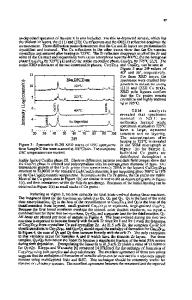Phase Transformations in Bulk (Ge2Se7)88Bi5Sb7
- PDF / 618,509 Bytes
- 6 Pages / 612 x 792 pts (letter) Page_size
- 112 Downloads / 350 Views
0918-H08-06
Phase Transformations in Bulk (Ge2Se7)88Bi5Sb7 Guy J. Adriaenssens Halfgeleiderfysica, University of Leuven, Celestijnenlaan 200D, Leuven, B-3001, Belgium ABSTRACT Annealing at 150 °C induces phase separation in amorphous (Ge2Se7)88Bi5Sb7 bulk samples. Spectrally resolved steady-state photoconductivity measurements indicate the presence of crystalline Bi2Se3 clusters in the annealed material, but also the subsequent gradual disappearance of this microstructure at room temperature. Similar annealing-induced metastable changes are observed in other elements of a (Ge2Se7)88BixSb12-x sample series. INTRODUCTION Bi-modified germanium selenides attracted attention in the past for their ability to show either p-type or n-type conductivity depending on their Bi concentration [1]. While the conductivity type reversal occurred near x = 10 in the original Ge20Se80-xBix sample series, Nagels et al. [2] detected n-type conduction from x = 6 on in (Ge2Se7)88BixSb12-x samples. No such conductivity type reversal was found in the Sb-modified germanium selenides [3], but Sb is often being added to germanium-based chalcogenides since it leads to complex bonding structures and thus facilitates the glass formation [4,5]. In the course of their study of the conductivity type reversal, Nagels et al. [6] used microprobe analysis and scanning electron microscopy to ascertain the homogeneity of the glasses. They observed that, although as-prepared Bi-modified germanium selenide samples showed no sign of phase separation when kept at room temperature, annealing the samples at 150 °C did induce such microstructure. Those observations referred to compounds that did not contain any Sb. However, as will be evidenced by this report, Sb-containing compounds exhibit similar behavior. Steady-state photoconductivity has already been used to examine the changes in electronic structure with changing composition of the (Ge2Se7)88BixSb12-x compounds [7]. It also offers the possibility to gain information on the location in the band gap of the electronic energy levels introduced by either co-ordination defects or modifying agents such as Bi. The technique will be used here, together with transient photocurrent measurements, to examine the annealinginduced changes in a series of (Ge2Se7)88BixSb12-x bulk samples. Those changes prove to be unstable at room temperature. Special attention will be paid to the (Ge2Se7)88Bi5Sb7 compound where one of the phase-separated components can be identified.
EXPERIMENTAL CONDITIONS Appropriate amounts of high-purity Ge, Se, Bi and/or Sb were sealed in evacuated quartz vials and allowed to react for a minimum of 10 hours at 1050 °C in a rocking furnace. (Ge2Se7)88BixSb12-x glasses, with x = 0, 4, 5, 6, 8 or 12, were then prepared by melt quenching in a water and ice mixture. X-ray diffraction measurements confirmed the amorphous nature of the
compounds. Suitable fragments of the ingots were polished and provided with evaporated Au contacts for electrical measurements. Some of the samples were then, after init
Data Loading...











